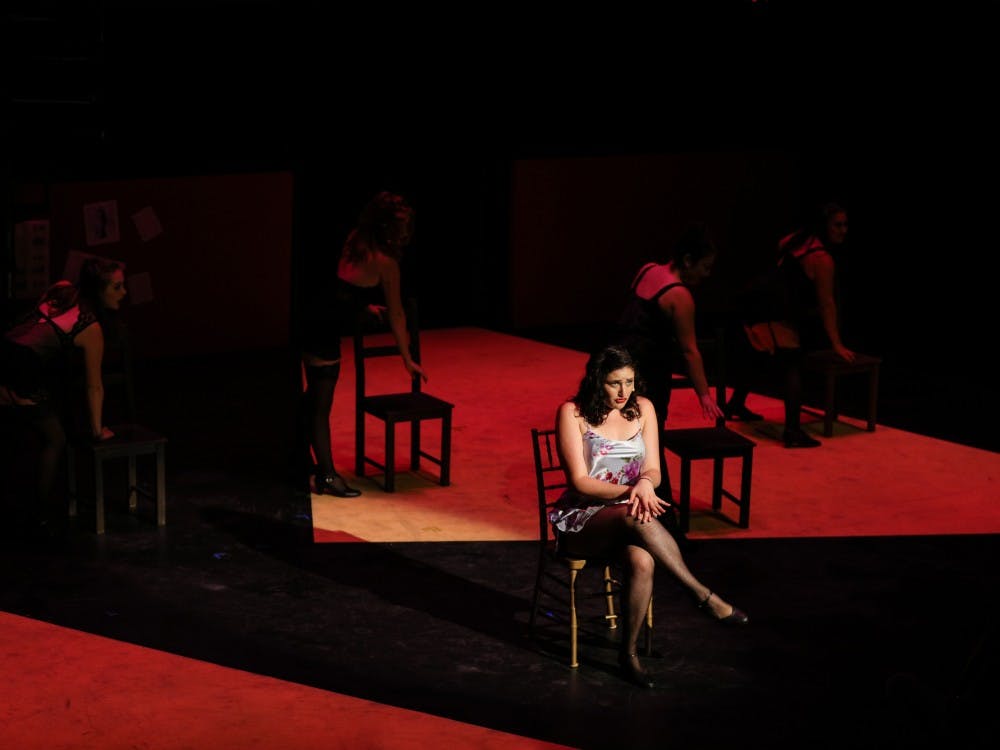From sex and money, to gender and sexuality, to bigotry and empathy, to loneliness and betrayal, there are certain topics that are undoubtedly hard to discuss. As young adults, these ideas become even more complicated, and art can help us understand them. After six weeks of arranging, choreographing and rehearsing, Hoof ‘n’ Horn presented “Cabaret” Oct. 17, an energetic yet reflective musical that sparks conversations about contentious issues.
“Cabaret” tells the story of struggling American writer Clifford Bradshaw (played by first-year Jeremy Oriss) as he desperately searches for inspiration for his novel in 1930s Berlin. Upon meeting extravagantly sensual English performer Sally Bowles (sophomore Tenley Seidel) at Berlin’s playfully scandalous Kit Kat Club, Cliff discovers a revolution in his life as well as in the sociopolitical climate of Germany. Featuring revealing costumes, sexually charged dancing, passionate ballads and a politically charged atmosphere, the musical explores the complexities of identity and underground movements in the early twentieth century.
What separates Hoof ‘n’ Horn’s rendition of “Cabaret,” however, is not only its powerful vocals and intricate choreography but its implementation of collaboration and a commitment to audience engagement.
Between the taboo topics, racy costumes, lighting changes and a jazzy orchestra pit, “Cabaret” exemplifies the importance of collaboration in musical theatre. Mastering each of these elements alone requires skill and hours of practice, so the combination of them is especially impressive. The cast, directors, producers, choreographers, orchestra and stage and tech crews come together harmoniously to enhance a dynamic, heartbreaking production.
“When I saw the tech elements come together with the performers for the first time, I began crying from the audience,” lead choreographer and junior Cady Bailey said. “It changes the energy of the show.”
This energy is not contained within the boundaries of the stage, either. Throughout the show, several members of the cast confidently walk up to random members of the audience or maintain prolonged eye contact with them, directly incorporating viewers as an active part of the show.
The Emcee, played by first-year Tommy Shen, guides the audience through each plot line and epitomizes the unconventionality of the play with an unapologetically androgynous style and flamboyant personality. In the opening number, he invites the audience to leave their problems at the door: “Life is disappointing, huh? Forget about it!” he declares.
This line is reflective of one of the most prominent themes of “Cabaret”: escapism. The musical takes place at a time when many Germans were suffering from economic hardships and rising political tensions, and immersing in the underground nightclub culture embodied by The Kit Kat Club allowed for a temporary escape from one’s problems. This culture was not solely about sex or money — it was about embracing the fluidity of sexuality, gender, class and identity. Women could dance in black heels and low-cut lace lingerie without shame; men could strut in pants and suspenders or glide in an evening gown without hesitation; anyone could come to The Kit Kat Club to be the most genuine version of themselves. As ideas regarding gender and promiscuity constantly evolve, the open acceptance of scandalous behavior becomes more pertinent to modern discussions of these topics.
“This show is just as powerful as it was when it was written in the 1960s,” Bailey said. “It’s important we look at the historical context of Cabaret and emphasize the relevance of it today.”
“Cabaret” is impactful not only for its timeless musical numbers and mature approach to sensitive topics, but for its undeniable political awareness. Taking place during the Nazi regime’s rise to power, the show raises important questions about the connection between political and social change: How can one stand against bigotry? Is ensuring the safety of loved ones worth risking your own security? Where is the line between ideology and morality? Is it possible for people of opposing political ideologies to maintain a friendship? And, most importantly, how do these questions apply to the sociopolitical issues of today?
“When I knew we were doing ‘Cabaret,’ I began researching the history of the time period,” Bailey said. “I had to ask, what would the dancing look like? The more I learned, the more I saw how the rhetoric of [1930s Germany] is similar to a lot of the rhetoric we hear today.”
Hoof ‘n’ Horn consistently showcases fantastic musicals put on by a talented cast and crew, but it is the group’s ability to expose young people to pressing issues that makes their productions stand out. By displaying an artful expression of serious topics, Hoof ‘n’ Horn effectively gives college students greater accessibility and interest in both learning and caring about these issues. If the youngest generation — our generation — remains silent, we contribute to the problem. The cast and crew of “Cabaret” recognize the significance of emphasizing social and political concerns, regardless of how controversial they may be.
“As young people, it’s our responsibility to pass on this information and keep it alive,” Bailey explained. “Yes, it’s hard, but we must ensure we aren’t bystanders in letting dangerous acts happen again. By keeping history alive, we can keep it from repeating itself.”
“Cabaret” will be playing in the Von Der Heyden Studio Theater at the Rubenstein Arts Center through Oct. 27. Although this weekend’s performances are sold out online and at the box office, anyone interested in seeing the show can join a waitlist one hour before each of this weekend’s performances.
Get The Chronicle straight to your inbox
Signup for our weekly newsletter. Cancel at any time.

